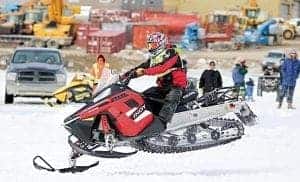There's no more trusted vehicle for Nunavummiut zipping around on the land than the snowmobile.

photo courtesy of Angulalik Pedersen
Keeping the machines in prime condition takes some know-how, and Rankin Inlet's Jackson Lindell has acquired those skills and knowledge, working as a professional mechanic.
He recommends an oil change and a new oil filter to start the season. Once should be enough for the full winter for most riders, he said.
If your battery is dead or sluggish, it's best to give it a slow “trickle” charge to restore it using a charger.
Snowmobile's rubberized tracks may require a bit of tightening, especially after the first year with new machines because they tend to stretch a bit, Lindell advised. The same goes for the chain in the chain-case.
“Usually what the manual calls for is if you're able to tighten it with your hand, you just tighten it all the way until you can't tighten it anymore and then you fasten it with the locknut at that position,” Lindell said of the chain.
The belt may also need adjustment to ensure it's at the proper height and tension.
“The more a belt is used, the more wear and tear. When you start seeing cracks in your belt, you know that you want to have a spare one or you want to change it,” he suggested.
If the primary clutch can be wiggled forwards and backwards, it's probably an indication that the bushings are starting to deteriorate and the clutch may start sticking, meaning those bushings are due to be changed.
Plastic ski rods may have to be replaced after two years if the machine is driven frequently or gets a lot of mileage on roads in the community.
Spark plugs on a four-stroke engine can usually last for three years or more – depending on use – but with two-stroke machines yearly replacement may be necessary, he said.
Come late spring or early summer, it's best to cover your snowmobile while it's not in use to prevent dust from infiltrating parts.
Also be careful with stored gas so that condensation doesn't build up, adding water to the gasoline, which is bad for engines.
Newly-purchased snowmobiles generally come with the tools required to perform basic maintenance, Lindell noted, adding that there are many helpful instructional videos online. He recommended speaking to a mechanic whenever in doubt.
“They usually stay up to date with the modern advances, all the accessories and the little tricks that he's learned on his own or through anecdotal conversation,” said Lindell. “Most times they'll be willing to say what's best for your type of machine.”
Some communities don't have the luxury of a certified mechanic to consult. In Hall Beach, Abe Qammaniq said residents often rely on friends and family to repair snowmobiles if they don't know how to do it themselves.
“Locally there's a handful who can repair four-stroke engines,” said Qammaniq. “Basically, there's a few who have the knack. They can take the engine apart, fix it, do the timing with a specialty tool. These are your neighbours. They have small snowmobile shacks that are kept warm. People utilize their friends. My cousins (fix snowmobiles) so I'm lucky like that.”